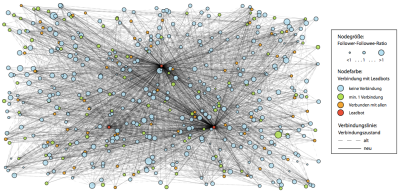Next week, my PhD student Claudia Wagner will present results from one of our recent studies on the susceptibility of users in online social networks at the #MSM2012 workshop at WWW’2012 conference in Lyon, France.
In our paper (download socialbots.pdf), we analyze data from the Socialbot Challenge 2011 organized by T. Hwang and the WebEcologyProject, where a set of Twitter users were targeted by three teams who implemented socialbots that were released “into the wild” (i.e. implemented and implanted on Twitter). The objective for each team was to elicit certain responses from target users, such as @replies or follows. Our work on this dataset aimed to understand and model the factors that make users susceptible to such attacks.
Our results indicate that even very active Twitter users, who might be expected to develop certain skills and competencies for using social media, are prone to attacks. The work presented in this paper increases our understanding about vulnerabilities of online social networks, and represents a stepping stone towards more sophisticated measures for protecting users from socialbot attacks in online social network environments.
The Figure below depicts the network of users and socialbots in our dataset (a set of users who were targeted by social bots during the Socialbot challenge), how they link to each other, and highlights those users who were susceptible to the attacks (green and orange nodes).

Susceptibility of users on Twitter who were targeted by socialbots during the Socialbot challenge 2011 (organized by T. Hwang and the WebEcologyProject). Each node represents a Twitter user: red nodes represent socialbots (total of 3), blue nodes represent users who did not interact with social bots, green nodes represent users who have interacted with at least one social bot, orange nodes represent users who have interacted with all social bots. Dashed edges represent social links between users which existed prior to the challenge, solid edges represent social links that were created during the challenge. Large nodes have a high follower/followee ratio (more popular users), small nodes have a low follower/followee ratio (less popular users). Network visualization generated by my student Simon Kendler.
Here’s the abstract of our paper:
Abstract: Social bots are automatic or semi-automatic computer programs that mimic humans and/or human behavior in online social networks. Social bots can attack users (targets) in on- line social networks to pursue a variety of latent goals, such as to spread information or to influence targets. Without a deep understanding of the nature of such attacks or the susceptibility of users, the potential of social media as an instrument for facilitating discourse or democratic processes is in jeopardy. In this paper, we study data from the Social Bot Challenge 2011 – an experiment conducted by the WebEcologyProject during 2011 – in which three teams implemented a number of social bots that aimed to influence user behavior on Twitter. Using this data, we aim to develop models to (i) identify susceptible users among a set of targets and (ii) predict users’ level of susceptibility. We explore the predictiveness of three different groups of features (network, behavioral and linguistic features) for these tasks. Our results suggest that susceptible users tend to use Twitter for a conversational purpose and tend to be more open and social since they communicate with many different users, use more social words and show more affection than non-susceptible users.
here’s the full reference, including a link to the article (socialbots.pdf):
Reference and PDF Download: C. Wagner, S. Mitter; C. Körner and M. Strohmaier. When social bots attack: Modeling susceptibility of users in online social networks. In Proceedings of the 2nd Workshop on Making Sense of Microposts (MSM’2012), held in conjunction with the 21st World Wide Web Conference (WWW’2012), Lyon, France, 2012. (download socialbots.pdf)

perda de peso do recem nascido
When social bots attack: Modeling susceptibility of users in online social networks | Intentialicious: Markus Strohmaier